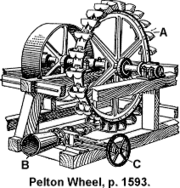Pelton wheel
|
|
Peltonturbine-1.jpg
A pelton wheel is one of the most efficient types of water wheel.
| Contents |
Function
Pelton-wheel.jpg
Nozzles direct forceful streams of water against a series of spoon-shaped buckets mounted around the edge of a wheel. Each bucket reverses the flow of water, leaving it with diminished energy. The resulting impulse spins the turbine. The buckets are mounted in pairs, to keep the forces on the wheel balanced, as well as to ensure smooth, efficient momentum transfer of the fluid jet to the wheel. The pelton wheel is a form of impulse turbine and is most efficient in high head applications.
Since water is not a compressible fluid, almost all of the available energy is extracted in the first stage of the turbine. Therefore, pelton wheels have only one wheel, unlike turbines that operate with compressible fluids.
History
Lester Allan Pelton, carpenter and millwright, invented the pelton wheel in 1879 while working in California. He obtained his first patent in 1880.
One story has Pelton inventing his wheel by noticing how water splashed out of the nostrils of a cow as it drank from a stream.
In another story he is inspired by a water wheel whose axle came loose while he was working on it. The water jet hit the edge of the water wheel bucket and reversed direction (instead of filling the bucket). Pelton observed an increase in speed of the mis-alligned wheel.
Applications
Peltons are the turbine of choice for high head, low flow sites. However, Pelton wheels are made in all sizes. There are multi-ton pelton wheels mounted on vertical oil pad bearings in the generator houses of hydroelectric plants. The largest units can be up to 200 Megawatts. The smallest pelton wheels, only a few inches across, are used with household plumbing fixtures to tap power from mountain streams with a few gallons per minute of flow, but these small units must have thirty meters or more of head. Depending on water flow and design, Pelton wheels can operate with heads as small as 15 meters and as high as 1,800 meters.
In general, as the height of fall increases, less volume of water can generate the same power. Energy is force times distance, and the higher pressure can apply the same force with less mass flow.
Every installation therefore has its own most-efficient pressure, speed and volume. Usually small installations use standardized buckets, and adapt the turbine to one of a family of generators and wheel sizes by using custom plumbing. Small turbines can be adjusted somewhat by varying the number of nozzles and buckets per wheel, and choosing different diameters of wheel. Large installations custom design the turbine's torque and volume to turn a standard generator.
Many small installations also can double as a developed source of pressurized household wash water, or animal feed water.
In areas where household water is sufficiently cheap, a pelton wheel can generate power from household water.
An unusual item in most pelton wheel installations is the governor. It modulates the flow of water based on the speed of the wheel.
See also
External links
- NASA site (http://www-istp.gsfc.nasa.gov/stargaze/Spelton.htm)
- Pelton wheel photos (http://home.clear.net.nz/pages/coote/pelton.html)
- MicroHydroPower Pelton Information (http://microhydropower.net/turbines.html#Pelton)de:Pelton-Turbine

